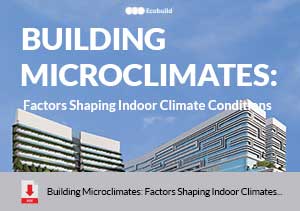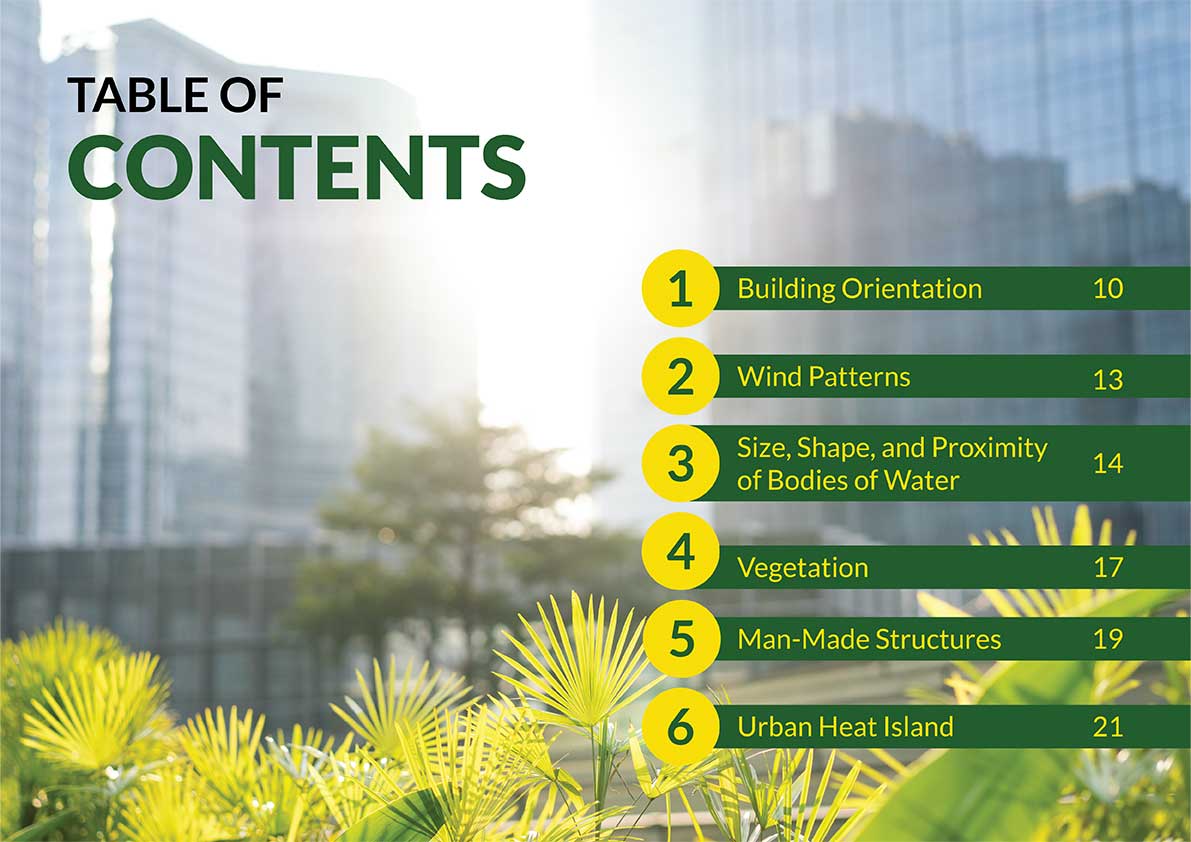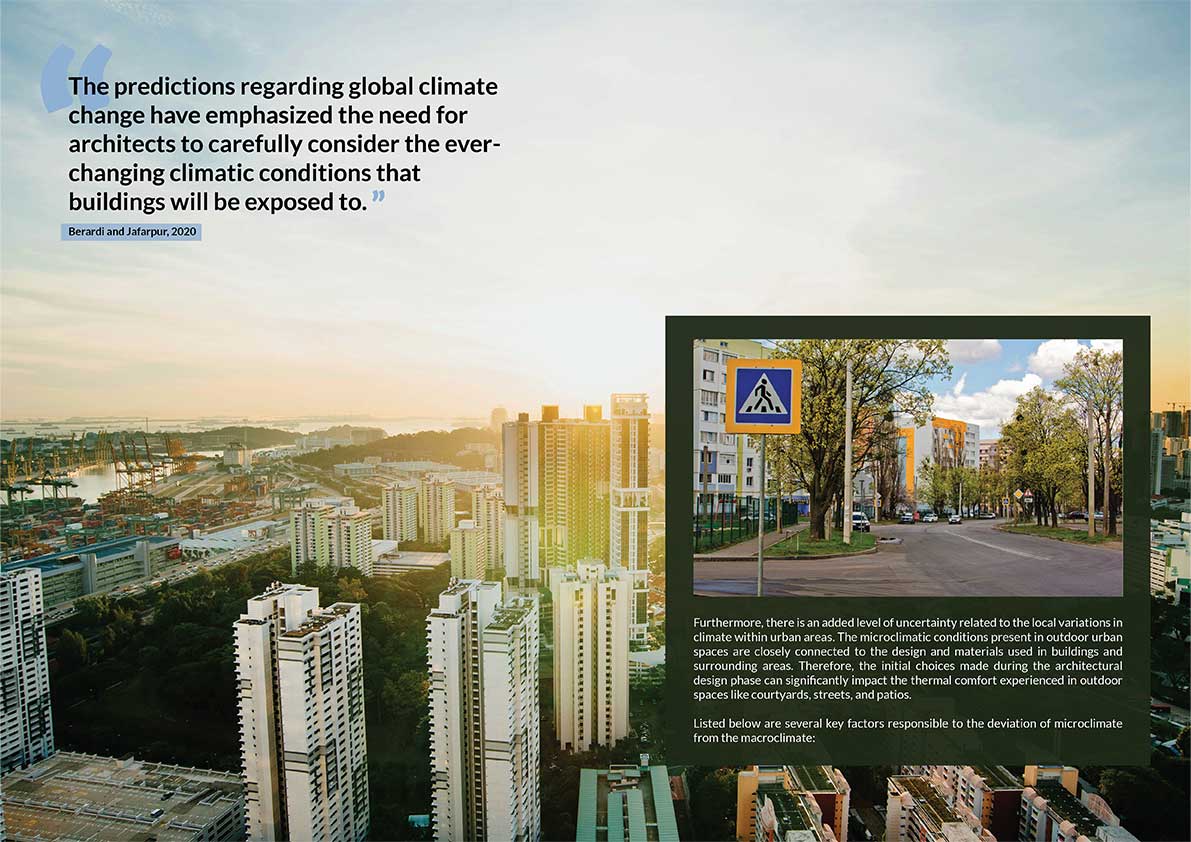The predictions regarding global climate change have emphasized the need for architects to carefully consider the ever-changing climatic conditions that buildings will be exposed to (Berardi and Jafarpur, 2020).
Furthermore, there is an added level of uncertainty related to the local variations in climate within urban areas. The microclimatic conditions present in outdoor urban spaces are closely connected to the design and materials used in buildings and surrounding areas. Therefore, the initial choices made during the architectural design phase can significantly impact the thermal comfort experienced in outdoor spaces like courtyards, streets, and patios.
Listed below are several key factors responsible to the deviation of microclimate from the macroclimate:
- Building Orientation
One of the primary advantages of proper building orientation is maximizing solar energy collection, shading, and daylighting (Lechner, 2014).
When windows are strategically placed to face south and north, the building can effectively harness solar energy, provide shading in appropriate areas, and maximize the use of natural daylight. This approach not only reduces dependence on artificial lighting but also leads to substantial energy savings.
An illustrative example of the impact of building orientation is when a building is rotated by 90 degrees, given the feasibility of the site. Such a rotation can result in a remarkable reduction of up to 40 percent in energy consumption for heating, cooling, and lighting (Lechner, 2014).
This significant decrease in energy usage can be achieved without any additional cost or investment.
- Wind Patterns
To address the evolving climate conditions, architects have devised a design approach that harnesses the power of wind.
This approach utilizes digital design tools to incorporate wind considerations throughout the design process, starting from urban planning and extending to the form-finding of buildings. It also encompasses the design of building surfaces, including texture and roughness, to optimize their interaction with the wind.
Architectural design, from urban configurations, through building shapes, to the local form of the façade, impacts the character of the wind flow, as well as the creation of turbulence, and acceleration or deceleration of the wind speed, which further influences the wind pressure on buildings (Kabosova, 2020).
- Size, Shape, and Proximity of Bodies of Water
The level of humidity in an environment is intricately tied to the process of water evaporation or vaporization.
As humidity approaches 100%, the rate of evaporation diminishes, posing challenges to the effective dissipation of sweat from the skin. Consequently, the reduced evaporation hinders the body’s natural cooling mechanism, leading to a heightened perception of ambient temperature and potentially contributing to discomfort in hot and humid conditions.
Therefore, these processes would help planners to assess and design appropriate strategies for managing microclimate conditions.
- Vegetation
Plants play a crucial role in the heating, cooling, and lighting of buildings, offering multiple benefits. Strategic placement and selection of plants in well-designed landscapes can lead to significant reductions in heating and cooling costs, potentially up to 25% (Lechner, 2014).
While plants are often appreciated for their aesthetic and psychological advantages, Kellet and Wilson (1993) suggest that humans have an inherent need for connections with various animal and plant species, known as biophilia.
Research has demonstrated that plants can enhance human health and performance. Patients recovering in hospitals tend to heal faster when they have views of greenery, compared to views of other buildings (Ulrich, 1984).
Similarly, students in classrooms and office workers exhibit improved scores and performance when they have access to larger views (Heschong, 2003), particularly of greenery.
They also can act as windbreaks during winter, provide shading and evaporative cooling in summer, and serve as year-round light filters. Vegetation also aids in erosion reduction, attracts wildlife, mitigates noise and air pollution, lowers carbon dioxide levels, increases oxygen levels, and can even act as visual barriers for privacy.
Consequently, incorporating vegetation into landscapes is a significant sustainability strategy. The more functions vegetation can serve, the more advantageous it becomes, aligning with the diverse functions of the building’s design elements.
- Man-Made Structures
Buildings, streets, and parking lots have a substantial impact on the microclimate due to their abundance, size, mass, and color (Lechner, 2014).
The presence of buildings can result in a significant alteration of the microclimate, as their shadows can create a cooler environment in what was previously a warm southern exposure, resembling a colder north-like orientation. Additionally, buildings can provide shade during hot summer days and act as barriers against cold winter winds.
Moreover, large expanses of pavement, particularly if made of dark-colored asphalt, can reach extremely high temperatures, reaching up to 140°F (60°C). This heated air can then spread to nearby areas, causing them to become excessively hot as well.
- Urban Heat Island
According to the UN’s World Urbanization Prospects (2018), urban populations exceeded rural populations, reaching 55% in 2018 and projected to reach 68% by 2050. This urbanization process has led to pollution and temperature increases, resulting in the Urban Heat Island (UHI) effect.
Dense urban areas with sealed surfaces and construction sites are more vulnerable to climate change compared to natural surfaces. UHI intensity is influenced by factors like wind speeds, cloud cover, season, city size, and time of day.
UHI has caused environmental changes and societal challenges in many cities. Human activities, such as industrialization and transportation, contribute directly to urban overheating and indirectly through air pollution that affects the atmosphere’s radiative properties.
Street canyons, U-shaped spaces between buildings, trap longwave radiation and increase temperatures due to reduced sky view factors. Therefore, developing urban planning guidelines based on street canyon geometry is crucial for microclimates and pedestrian-level thermal comfort.
Climate interactions with buildings are complex. Urban buildings consume more cooling energy compared to rural buildings.
This effect is more pronounced at night, reducing the building’s cooling capacity. Climate-based design approaches are necessary to address UHI. Tropical cities experience constant heat, high temperatures, and significant UHI effects, particularly during the daytime in the rainy season. In contrast, temperate climates have more intense UHI effects at night and during periods of high temperatures and low precipitation.
Tropical climates generally exhibit higher UHI intensity, with temperature differences exceeding 6°C. Urban heat islands have detrimental effects on quality of life, impacting not only environmental conditions but also human health. Prolonged exposure to elevated temperatures increases the risk of dehydration.
Integrating green buildings into urban planning is essential to mitigate these issues. Creating more green spaces and utilizing environmentally friendly building materials are effective strategies to reduce temperatures, promote airflow, and decrease direct sunlight radiation.
Closing statement:
To conclude, the concept of microclimate provides insight into the temperature variations observed in different areas, such as rural and urban regions, despite minor differences in elevation.
Urban areas characterized by high-density buildings and pollution tend to experience warmer microclimate temperatures. If left unaddressed, this temperature rise can contribute to the formation of urban heat islands, which have detrimental effects on the overall quality of life.
Therefore, it becomes imperative to prioritize the implementation of green building concepts aimed at mitigating urban heat islands, regulating microclimates, and ultimately enhancing the well-being of individuals residing in these affected areas.
You can read the full article about Building Microclimates: Factors Shaping Indoor Climate Conditions below.





